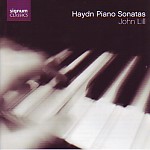Listen to the opening theme of the minuet finale of Sonata No. 49: those B-naturals would make you swear that this is Prokofiev in his “classical” mode. It’s just one indication of how much variety awaits in these wonderful sonatas, and John Lill (“Ohn Lill” on the back tray card) proves himself largely responsive to the music’s wide-ranging expression. The selection of works is very well planned: the Sonata in C-sharp minor (No. 36) ends in that key; the next work, No. 44 in G minor turns to the major, and so sets up the two big works in E-flat. From the opening Moderato of No. 36, Lill offers interpretations on a grand scale, taking full advantage of the modern piano’s imposing sonority and dynamic range.
On the debit side, sometimes this can be too much of a good thing. He’s a touch heavy-handed in the opening movements of both E-flat sonatas, and the engineering tends to emphasize Lill’s fondness for booming bass lines. His Adagio in Sonata No. 52 also lacks the flow of, say, Hamelin in his recent astounding Haydn sonata recording for Hyperion (though this is the only work the two programs have in common). With just a little more variety of articulation and rhythmic lightness this recital could have been truly special. As it is, it’s a very good specimen of big-boned Haydn, and if that’s your preference then you will likely enjoy Lill’s approach. In Sonata No. 52, though, I’m sticking with Hamelin, and for period-instrument fans, don’t forget Brautigam’s splendid cycle on BIS.
































